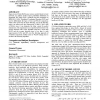146 search results - page 24 / 30 » Sequential Traitor Tracing |
ICDE
2009
IEEE
13 years 6 months ago
2009
IEEE
There is a huge wealth of sequence data available, for example, customer purchase histories, program execution traces, DNA, and protein sequences. Analyzing this wealth of data to ...
DIMVA
2007
13 years 10 months ago
2007
Abstract. We present two light-weight worm detection algorithms that offer significant advantages over fixed-threshold methods. The first algorithm, RBS (ratebased sequential hy...
INFOCOM
2009
IEEE
14 years 3 months ago
2009
IEEE
—Compromised machines are one of the key security threats on the Internet; they are often used to launch various security attacks such as DDoS, spamming, and identity theft. In t...
WWW
2008
ACM
14 years 9 months ago
2008
ACM
Rogue Access Points (RAPs) pose serious security threats to local networks. An analytic model of prior probability distribution of Segmental TCP Jitter (STJ) is deduced from the m...
POPL
2009
ACM
14 years 3 months ago
2009
ACM
Speculative execution is an important technique that has historically been used to extract concurrency from sequential programs. While techniques to support speculation work well ...

